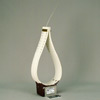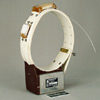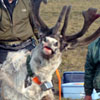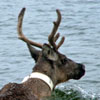Gen4 GPS and VHF Systems for Caribou

Caribou in Greenland. Photo courtesy of Christine Cuyler.
GPS/Iridium Key Features
- NEW: Geofencing is now available.
- NEW: Two way scheduling changes are now available.
- The system can be programmed to store high accuracy standard GPS and/or QFP positions in memory. QFP is Telonics' new rapid fix GPS technology that obtains the data necessary to calculate a GPS positions in as little as 3-5 seconds. QFP technology has been used in marine applications for several years and is now making its way into terrestrial applications. The technology can be used to increase the number of positions collected or extend the time over which positions are collected by as much as 3-6 times relative to standard GPS positioning. Location accuracy for GPS/QFP is virtually the same as standard GPS.
- Other biologically significant data that can be collected include activity level, temperature, and mortality events. For some marine mammal applications (e.g., polar bears) a saltwater switch can provide information on time spent in and out of sea water.
- Real-time clock calendar (RTC) controls all timing functions and is re-synchronized with GPS time to assure high accuracy event timing.
- Shutdown with a small magnet allows users to turn each of these configurations "on" or "off". When turned "off", TGW-4xxx series based units consume less than 12 µA. Given these low current levels, users can store their units for extended periods with minimal impact on operational life.
- Units can be refurbished to their original condition at the factory.
- All products can be programmed by Telonics Product Programmer (TPP) which uses a graphical user interface. TPP makes it possible for users to program their own systems and simulate performance of the system prior to deployment.
- On-board sensors can be activated or deactivated in the field. Data collection regimes and schedules can be altered as required. Collected sensor data can be selectively included in Iridium uplink transmissions.
- Data Decoding - Data are processed using the Telonics Data Converter (TDC), which supports both the Iridium data collection distribution and the direct download of memory using the TSC-4 or the TSC-7 cable. TDC provides a comma separated value (csv) output file with time stamps for all data collected. TDC can be run interactively, or in "batch mode" for hands-off operation. TDC allows you to plot GPS fixes and GPS-QFP locations for presentation using Google Earth.
Iridium Data Transfer System Features
- Complete global coverage with 66 satellites in the constellation orbiting at 780 km above the earth. Additional satellites will bring the constellation to 81 in 2015.
- Intra-satellite communication means that signals do not rely on ground stations being in-view to transfer data and the system has true worldwide coverage.
- Two-way communications allows for confirmation of received transmissions, so the system does not need to resend data over and over again.
- The system is always available for real time data transfer.
GPS/Iridium Models
Daily Iridium uplinks and immediate notification of mortality
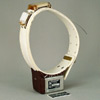
| Model |
Dimensions L x W x H (in, cm) |
Canister Weight (g) |
Estimated Weight with Collar (g) |
Operational Life
1 Year |
Monthly Service Fee
1 Year |
Operational Life
2 Years |
Monthly Service Fee
2 Years |
Operational Life
5 Years |
Monthly Service Fee
5 Years |
| TGW-4570-3 |
2.9 x 2.3 x 2.0
7.4 x 5.8 x 5.1 |
340 |
700-1100 |
34 fixes per day |
$14 |
16 fixes per day |
$10 |
4 fixes per day |
$10 |
| TGW-4670-3 |
3.25 x 2.75 x 2.25
8.3 x 7.0 x 5.7 |
625 |
1100-1200 |
79 fixes per day |
$16 |
37 fixes per day |
$14 |
12 fixes per day |
$10 |
Average time to fix of 75 seconds, Average temperature of 25°C
1500ms VHF pulse period, VHF on for 16 hours per week.
There is a one-time activation fee of $40 in addition to monthly fees.
GPS Manual
For Electronic and Packaging Specifications, please see the Gen 4 GPS User's manual.
GPS/Globalstar Key Features
General Features
- The system can be programmed to store high accuracy standard GPS and/or QFP positions in memory. QFP is Telonics' new rapid fix GPS technology that obtains the data necessary to calculate a GPS positions in as little as 3-5 seconds. QFP technology has been used in marine applications for several years and is now making its way into terrestrial applications. The technology can be used to increase the number of positions collected or extend the time over which positions are collected by as much as 3-6 times relative to standard GPS positioning. Location accuracy for GPS/QFP is virtually the same as standard GPS.
- Other biologically significant data that can be collected include activity level, temperature, and mortality events. For some marine mammal applications (e.g., polar bears) a saltwater switch can provide information on time spent in and out of sea water.
- Shutdown with a small magnet allows users to turn each of these configurations "on" or "off". When turned "off", TGW-4xxx series based units consume less than 12 µA. Given these low current levels, users can store their units for extended periods with minimal impact on operational life.
- Units can be refurbished to their original condition at the factory.
- Data Decoding - Data are processed using the Telonics Data Converter (TDC), which supports both the Globalstar data collection distribution and the direct download of memory using the TSC-4 or the TSC-7 cable. TDC provides a comma separated value (csv) output file with time stamps for all data collected. TDC can be run interactively, or in "batch mode" for hands-off operation. TDC allows you to plot GPS fixes and GPS-QFP locations for presentation using Google Earth.
- All products can be programmed by Telonics Product Programmer (TPP) which uses a graphical user interface. TPP makes it possible for users to program their own systems and simulate performance of the system prior to deployment.
- On-board sensors can be activated or deactivated in the field. Data collection regimes and schedules can be altered as required. Sensor data can be enhanced or deleted from Globalstar uplink transmissions.
- Real-time clock calendar (RTC) controls all timing functions and is re-synchronized with GPS time to assure high accuracy event timing.
Globalstar Data Transfer System
- The Globalstar satellite network consists of 48 space vehicles in low-earth orbit (LEO). Overpasses provide continuous coverage over most of the globe but the system is not worldwide as ground stations must be in mutual view.
- Data received by the satellite is relayed to a ground station in real time. Transmissions that successfully negotiate these links are delivered directly to the end user within minutes, usually via e-mail.
- The simplex Globalstar system is a one-way system. Messages are up to 144 bytes in length and units may be on the air for up to 26 seconds. Data must be retransmitted to increase the probability that the information will be received. Globalstar requires transmitters to wait approximately 30 minutes before generating the next transmission.
- The system is available continuously and therefore supports real time data transfer.
- Telonics GPS Globalstar units are FCC and IC certified and available for use throughout the United States and Canada with no additional licensing required for the data transfer component.
GPS/Globalstar Models
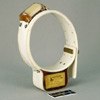
| Model |
Dimensions L x W x H (in, cm) |
Canister Weight (g) |
Estimated Weight with Collar (g) |
Operational Life
1 Year |
Monthly Service Fee
1 Year |
Operational Life
2 Years |
Monthly Service Fee
2 Years |
Operational Life
5 Years |
Monthly Service Fee
5 Years |
| TGW-4460-3 |
2.78 x 1.8 x 1.42
7.0 x 4.5 x 3.5 |
210 |
416-582 |
58 fixes per week,
13 uplinks per week |
$8 |
30 fixes per week,
6 uplinks per week |
$5 |
|
|
| TGW-4560-3 |
2.9 x 2.3 x 2.0
7.4 x 5.8 x 5.1 |
340 |
700-1100 |
20 fixes per day,
4 uplinks per day |
$14 |
10 fixes per day,
2 uplinks per day |
$8 |
25 fixes per week,
5 uplinks per week |
$5 |
| TGW-4660-3 |
3.25 x 2.75 x 2.25
8.3 x 7.0 x 5.7 |
625 |
1100-1200 |
45 fixes per day,
9 uplinks per day |
$29 |
20 fixes per day,
4 uplinks per day |
$14 |
59 fixes per week,
12 uplinks per week |
$7 |
Average time to fix of 75 seconds, Average temperature of 25°C.
Monthly service fee assumes 50% transmission success.
There is a one-time activation fee of $30 in addition to monthly fees.
GPS Manual
For Electronic and Packaging Specifications, please see the Gen 4 GPS User's manual.
GPS/Argos Key Features
- Lower current consumption provides a 100% increase in operational life or an increase in performance during that same operational time frame.
- The newest GPS receiver technology provides faster time to fix.
- Up to 24 positions per day can be recovered through Argos by using the innovative paging date protocol.
- More flexible programming schedules available to the user.
- Single printed wiring board construction and higher integration makes the electronics more rugged and increases reliability in high shock/vibration environments.
- All products can be programmed by Telonics Product Programmer (TPP) which uses a graphical user interface. TPP makes it possible for users to program their own systems and simulate performance of the system prior to deployment.
- The Telonics Data converter (TDC) provides complete data decoding of Argos DS files and supports complete memory downloading. TDC provides a standard csv output file (comma separated value) with time stamps for all data collected. TDC can be run in the "batch mode" for hands off operation.
- TDC allows you to plot GPS fixes and Argos locations with Google Earth.
- Various attachment options have been designed specifically for ungulate species
GPS/Argos Models
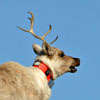
| Configuration |
Dimensions L x W x H (in, cm) |
Canister Weight (g) |
Estimated Collar Weight (g) |
Operational Life
1 Year |
Operational Life
2 Years |
Operational Life
5 Years |
| TGW-4480-3 |
2.78 x 1.8 x 1.42
7.0 x 4.5 x 3.5 |
210 |
416-582 |
10 fixes per day, 5-hour uplink every 3 days |
5 fixes per day, 5.5-hour uplink every 7 days |
|
| TGW-4583-3 |
2.9 x 2.3 x 2.0
7.4 x 5.8 x 5.1 |
340 |
700-1100 |
27 fixes per day, 4.25-hour uplink every day |
13 fixes per day, 4.3-hour uplink every 2 days |
5 fixes per day, 6-hour uplink every 8 days |
| TGW-4680-3 |
3.25 x 2.75 x 2.25
8.3 x 7.0 x 5.7 |
625 |
1100-1200 |
54 fixes per day, 9-hour uplink every day |
27 fixes per day, 4.3-hour uplink every day |
10 fixes per day, 3.3-hour uplink every 2 days |
Average time to fix of 75 seconds, 150-second repetition rate, Average temperature of 25°C.
GPS Manual
For Electronic and Packaging Specifications, please see the Gen 4 GPS User's manual.
VHF Key Features
- Multiple power levels to accommodate greater range or greater life
- Duty cycling and seasons based on calendar dates and times to extend operational life
- Mortality sensing based on a motion or temperature threshold
- Optionally reports the elapsed time since mortality is detected
- Monitors activity intensity or an active/inactive threshold
- Field programmable with Telonics Product Programmer
VHF Models
Standard Collar Systems
| Model |
Dimensions L x W x H (in, cm) |
Canister Weight (g) |
Life @60BPM
Standard Power (months) |
Transmitter Electronics |
| MOD-315-3 |
1.4 x 1.4 x 1.1
3.6 x 3.6 x 2.8 |
100 |
19.8 |
MK-11 |
| MOD-315-2 |
1.4 x 1.4 x 1.1
3.6 x 3.6 x 2.8 |
100 |
22.3 |
MK-12 |
| MOD-400-3 |
2.4 x 1.5 x 1.3
6.1 x 3.8 x 3.3 |
175 |
31 |
MK-11 |
| MOD-400-2 |
2.4 x 1.5 x 1.3
6.1 x 3.8 x 3.3 |
175 |
35.3 |
MK-12 |
| MOD-500-3 |
2.7 x 2.0 x 1.5
6.9 x 5.1 x 3.7 |
265 |
68 |
MK-11 |
| MOD-500-2 |
2.7 x 2.0 x 1.5
6.9 x 5.1 x 3.7 |
265 |
77.0 |
MK-12 |
| MOD-600-3 |
3.0 x 2.7 x 1.9
7.6 x 6.8 x 4.9 |
485 |
123 |
MK-11 |
| MOD-600-2 |
3.0 x 2.7 x 1.9
7.6 x 6.8 x 4.9 |
485 |
136 |
MK-12 |
Implantable Systems
| Model |
Dimensions L x W x H (in, cm) |
Canister Weight (g) |
Life @60BPM Std Pow (months) |
Life @60BPM Min Pow (months) |
Transmitter Electronics |
Transmitter Options |
| IMP-200 |
2.4 x 0.9
6.1 x 2.3 |
25 |
7.5 |
19.2 |
MK8 |
MS6, MA, MS9, MDC, MS4, MS5 |
| IMP-325 |
3.7 x 0.9
9.4 x 2.3 |
42 |
15 |
38.3 |
MK8 |
MS6, MA, MS9, MDC, MS4, MS5 |
| IMP-400 |
3.8 x 1.3
9.7 x 3.3 |
~95 |
31.8 |
81.2 |
MK8 |
MS6, MA, MS9, MDC, MS4, MS5 |
*There are more implant configurations that may prove to be better suited to a specific application. To view additional configurations, click here. To view heart rate configurations, click here.
Sensor Options for VHF Transmitters using the MK-11 or MK-12 Electronics
MK-11 or MK-12 Sensor Options - Show
Current Telonics VHF transmitters use either the MK-11 or MK-12 electronics. Sensor options available with these transmitters are described below grouped by primary use: mortality, activity, and temperature monitoring. There is some overlap between sensor types and how they are used, with typical uses as described. If you have questions about sensors or how they might best be implemented in your study please call Telonics to discuss your application.
Changes in motion or temperature are detected by unit's sensors and result in changes in the units transmitted pulse period. Pulse period is the time between the start of one transmitted pulse and the start of the next transmitted pulse, and it is measured in milliseconds (ms). Pulse rate in beats per minute (bpm) = pulse period/60,000.
With inclusion of the Data Logging Option, sensor data can also be stored-on-board the transmitter and downloaded using Telonics Data Converter (TDC) at the end of the study if the transmitter can be recovered.
Both the MS6 mortality-motion option and the MA activity option use an on-board accelerometer as the sensor to detect changes in position and acceleration in three axes. The sensor is sampled and each second is classified as active or not depending on whether a change in position or acceleration has been detected in that second.
The MS4 temperature option and MS5 temperature-triggered mortality option are based on an on-board thermistor used to measure temperature.
The MS6 mortality option can be enabled in conjunction with the MA activity sensor or MS4 temperature sensor. In such cases the activity or temperature sensor will be used to determine the active/alive pulse period.
Other sensors cannot simultaneously be used to control the transmitted pulse period, but if the Data Logging Option is purchased, multiple sensing options (e.g. MA activity and MS4 temperature) can be purchased and their resultant data stored-on-board the transmitter.
Mortality Sensing Options:
Mortality - Motion sensor (MS6)
This option provides active/alive and inactive/mortality pulse periods. Depending on the length of time over which activity is evaluated (time-out interval), this sensor can be thought of as either a mortality sensor (e.g. timeout interval of 4-12 hours) or as a motion sensor (e.g. with a timeout interval of seconds to minutes). Typically it is used as a mortality sensor, which is the most common sensor option used.
Users specify the following:
- Time-out interval over which the active versus inactive evaluation is made,
- Minimum number of active seconds to keep the transmitter in the active pulse rate (5 seconds is the default),
- Active pulse rate or period,
- Inactive pulse rate or period.
For example, if the time-out was defined as 6 hours, the default 5 active seconds was used, active pulse period was 1000ms (60 bpm), and inactive pulse period was 600ms (100 bpm); then as long as there were at least 5 active seconds in the preceding 6 hours, the pulse rate would be 60 bpm. If 6 hours elapsed with fewer than 5 active seconds the pulse rate would shift to 100 bpm. If ≥ 5 active seconds were again detected within any 6 hour window (e.g. if a scavenger moves the transmitter), the pulse rate would immediately switch back to 60 bpm.
When used as a mortality sensor, the active pulse rate is typically set to a comfortable tracking rate (often ~50-60 bpm), and the inactive/mortality pulse rate is faster. This helps conserve battery life because the active rate will be common, and the inactive rate rare. Users may alternatively select a slower inactive rate; for example, such programming is commonly used on bears which hibernate and are inactive for long periods of time.
If this sensor is used with short time-out intervals (e.g. minutes rather than hours), it serves as a motion sensor, rather than a mortality sensor. Operation is as noted above, but the inactive mode would be triggered much more frequently than with long time-outs. Such short time-outs are uncommonly used, but with an example application being to help determine the effect of disturbances on resting animals by having the inactive rate triggered after a few minutes of inactivity, but with the active rate immediately triggered if the animal is startled and begins moving.
When the MS6 option is activated, date and time of the most recent 9-16 changes from active to inactive or back are stored by the transmitter. This data can be downloaded using Telonics Product Programmer (TPP).
The MS6 option can alternatively be selected to provide information on how long it has been since the animal died or became inactive by having the inactive/mortality pulse periods related to how long the transmitter has been in that mode. If ordering the option with this feature, four additional values are specified:
- Maximum elapsed time of concern after mortality is detected (up to 1000 days),
- Pulse period that corresponds to the specific time when mortality is detected,
- Pulse period that corresponds to the maximum time of concern after mortality is detected,
- Whether a simple linear scale or a segmented scale of 2-8 pieces is used. A linear scale provides constant resolution over the defined range of pulse periods. A segmented scale allows finer resolution of elapsed time immediately after mortality is detected and coarser resolution later on. Each segment has resolution that is twice as coarse as the segment before it. Telonics provides a graph and linear equations to convert an observed pulse period into an elapsed time.
Temperature-Triggered Mortality option (MS5)
This option is designed to change pulse period/rate when measured temperature drops below a user-specified value. If temperatures rise back above the defined value, pulse period will change back to the default/higher temperature period. A typical use would be to detect mortality in an implantable transmitter in an endothermic animal, where temperature rather than motion could be a better indicator of mortality. For example, it has been used in waterfowl where waves could prevent a motion-based mortality sensor from detecting mortality. Another use of this option has been in vaginal implants to determine parturition, where the temperature would drop and the pulse period change when the unit was expelled. This option might not be suitable in areas where a high ambient temperature prevents the transmitter from cooling after death or parturition.
Users specify the following:
- trigger point temperature
- pulse period above the trigger point temperature
- pulse period below the trigger point temperature
With this option, an alternative is to have a range of pulse periods determined by how long it has been since the animal died (temperature dropped below the defined threshold). This operates as described above for the MS6 sensor.
Activity Sensing Options:
Activity Sensor (MA)
This option adjusts pulse period based on the amount of activity within a user-defined interval. The pulse period can either be defined as one of two periods (active versus inactive) or scaled over a range of pulse periods. Changes in pulse period step through time; e.g. the amount of activity in interval 1 determines the pulse period in interval 2, activity in interval 2 determines pulse period in interval 3, and so on. Thus, the pulse period being transmitted always reflects the amount of activity in the prior activity data collection interval. This is illustrated in tabular form below.
| Collecting data for interval X |
Collecting data for interval X+1 |
Collecting data for interval X+2 |
Collecting data for interval X+3... |
| Transmitting pulse period from interval X-1 data |
Transmitting pulse period from interval X data |
Transmitting pulse period from interval X+1 data |
Transmitting pulse period from interval X+2 data... |
Active/Inactive mode: In each defined interval, one of two pulse periods is transmitted depending on the amount of activity in the proceeding interval.
Users specify the following:
- Classification interval (1-second default, but selectable between 1-255 seconds)
- Active pulse period,
- Inactive pulse period,
- Time interval over which data is evaluated (up to 100 minutes)
- Number of active classification intervals (typically seconds) required for the time interval to be considered active. If any activity is detected during the defined classification interval that interval is considered active.
For example, the classification interval could be defined as 1-second, active pulse period 1000ms (60 bpm), inactive pulse period 1500ms (45 bpm), the time for accumulation of data as 1-minute, and the number of active seconds required to designate as active as 10 seconds. In this case the VHF would operate at either 45 or 60 bpm depending on whether the number of active seconds was <10 or ≥10 in the prior 1-minute accumulation period.
Scaled pulse period mode: In each defined interval, pulse period is scaled within a user-defined range based on the amount of activity in the preceding interval.
Users specify the following:
- Classification interval (1-second default, but selectable between 1-255 seconds),
- Range of pulse periods to be used for scaling,
- Time interval (1 second up to 18 hours) over which activity is evaluated.
For example, the classification interval could again be 1-second, data could be summed over a 10-minute time interval, and the range of possible pulse periods could be 1000-3000. In such case, pulse periods would vary between 1000 and 3000ms (60-20 bpm) depending on the amount of activity in the prior 10-minute accumulation period. Increased levels of activity would result in shorter pulse periods.
With this option the user can also select whether the relationship between activity and period is linear or a segmented scale (with 2-8 segments). A linear scale provides a constant resolution between the number of active classification intervals and pulse period over the specified range. Segmented scales provide different resolution for each segment, with the first segment (starting at 0 activity counts) having the best resolution, and each following segment with resolution that is twice as coarse as the segment before it. Telonics provides a graph and linear equations to convert an observed pulse period into a number of "active classification intervals" over the update period.
Mortality - Motion Sensor Option (MS6)
If this sensor is used with short time-out intervals (e.g. minutes rather than hours), it serves as a motion sensor, rather than a mortality sensor. Operation is as noted in the more detailed description under Mortality Sensing Options above, but the inactive mode would be triggered much more frequently than with long time-outs. An example of such use is to help determine the effect of disturbances on resting animals by having the inactive rate triggered after a few minutes of inactivity, but with the active rate immediately triggered if the animal is startled and begins moving.
Temperature Sensor (MS4)
This option measures temperature at a defined sampling interval and causes pulse period to change with changes in temperature. Telonics provides a graph and linear equation to convert an observed pulse period into a temperature. Temperature sensing transmitters have uncalibrated accuracy shown in the table below. If higher accuracy is desired, the user can calibrate individual units.
Users specify the following:
- Sampling interval (1 second to 18 hours),
- Low-end temperature of concern with a corresponding pulse period,
- High-end temperature of concern with a corresponding pulse period.
Option 400 is the standard version of this sensor. It has a thermistor mounted on the electronics board (thus measuring internal package temperature, which may differ from either ambient or body temperature), and is centered at 37°C.
Option 401, is similar to Option 400, but the thermistor is centered at 14°C.
If you have a need for an externally mounted thermistor, please contact Telonics to discuss your application.
Sensor details:
| Opt: 400 (onboard) - Thermistor centered at 37° C |
|---|
| Range = -40 to +70° C |
|---|
| Resolution: | 1.041° @ -40°
0.087° @ +37°
0.162° @ +70° |
| Uncalibrated accuracy: | ±0.47° typ, ±3.35° max |
| Range = +14 to +47° C |
|---|
| Resolution: | better than 0.1° |
| Uncalibrated accuracy: | ±0.28° typ |
| Calibrated accuracy: | ±0.09° typ (plus cal error) |
| Opt: 401 (onboard) - Thermistor centered at 14° C |
|---|
| Range = -40 to +70° C |
|---|
| Resolution: | 0.39° @ -40°
0.076° @ +14°
0.342° @ +70° |
| Uncalibrated accuracy: | ±0.39° typ, ±2.0° max |
| Range = -10 to +32° C |
|---|
| Resolution: | better than 0.1° |
| Uncalibrated accuracy: | ±0.28° typ |
| Calibrated accuracy: | ±0.08° typ (plus cal error) |
Calibration, if desired, is the responsibility of the user, consisting of a 1-point calibration at the listed temperature.
Data Logging Option (Option 350) - Show
The Data Logging Option for MK-11 and MK-12 transmitters (Option 350) allows sensor data from the MS6 mortality-motion sensor, MA activity sensor, and/or the MS4 temperature sensor to be stored in transmitter memory and made available for download if the transmitter is able to be retrieved at the end of a study. Additional information regarding how these sensors work is provided in the Sensor Options section below. This option requires use of Telonics Data Converter to download the stored data.
For the MS6 motion-mortality sensor, the data logging records each date and time the sensor switches from active/alive to inactive/mortality or back. Assuming that no other sensor measurements are being stored, the data log can accommodate about 0.5 million transitions. Note that smaller units may not have sufficient battery capacity to fill the memory. The most recent 9-16 such transitions are recorded even without this option, but this option stores all such transitions.
For the MA activity sensor, the data logging option stores accelerometer data at user-defined intervals. These intervals may be the same throughout the anticipated life of the transmitter or they may change "seasonally". The activity data recorded is the number of active seconds (or other defined classification interval) during a defined collection interval. For example the number of active seconds in a one hour collection interval would be saved as a number between 0-3600. Assuming that no other sensor measurements are being stored, the data log can accommodate about 2.0 million measurements based on 30sec, 1 minute, or 5 minute intervals or about 1.3 million based on longer intervals. The activity collection schedule for data logging is independent of any activity schedule selected to control pulse rate.
For the MS4 temperature sensor, the data logging option stores temperature data at user-defined intervals (in 0.16°C increments). These intervals may be the same throughout the anticipated life of the transmitter or they may change "seasonally". The data log can store an estimated 1.3 million measurements if no other sensor data are stored. The temperature collection schedule for data logging is independent of any temperature schedule selected to control pulse rate.
Specifications for Transmitter Electronics
MK11/12 Transmitter General Specifications - Show
MK-11 and MK-12 beacons are microprocessor controlled pulsed-CW transmitters, designed for operation within the 137 - 225 MHz frequency range. Each MK-11 beacon transmits on a single, field-programmable frequency (within the frequency range that is ordered). MK-11 beacons also support 3 field-programmable power levels. The MK-12 beacon is crystal based, and therefore each beacon is built to operate on a specific frequency and with a specific power output (four power levels to choose from when ordering).
| Frequency Range |
MK11:
137 - 143 MHz (option 700),
143 - 156 MHz (option 710),
154 - 164 MHz (option 720),
162 - 174 MHz (option 730),
164 - 182 MHz (option 740),
182 - 201 MHz (option 750),
201 - 222 MHz (option 760)
MK12:
140 - 225 MHz
|
| Frequency Tolerance |
MK11:
Calibration: ±3 ppm max at room temperature / ±5 ppm from -40° to +70°C
Aging: <1ppm/yr
Shock: <1ppm 3000g x 0.2ms x ½ sine x 3 directions
MK12:
Calibration: ±17 ppm at room temperature / ±25 ppm from -40° to +70°C
Load: <7ppm typical for VSWR < 6:1
Supply Voltage: <3ppm typical over supply voltage range at 25°C
Aging: <1ppm/yr
Shock: <1ppm 3000g x 0.2ms x ½ sine x 3 directions
|
| VSWR Stability |
MK11: RF output stable to 10:1 VSWR, all phases.
Radiated harmonic levels are degraded with poor load VSWR.
Spurious emission specification maintained for > 10:1 VSWR.
MK12: RF output stable to 5:1 VSWR, all phases.
Radiated harmonic levels are degraded with poor load VSWR.
Spurious emission specification maintained for > 5:1 VSWR.
|
Output Power
|
| MK11: Field Programmable using TPP |
| Transmit Power |
Peak Power Output
Relative to Medium Power |
| Low |
0.5 * Medium Power |
| Med |
|
| High |
2.0 * Medium Power |
| MK12: Ordering Options for Power Level |
| Option |
Transmit Power |
Peak Power Output Levels
Relative to Standard Power |
| 200 |
Low (Temperature > -20°C) |
0.5 * Medium Power (Higher efficiency) |
| 202 |
Low |
0.5 * Medium Power |
| 204 |
Medium |
|
| 206 |
High |
2.0 * Medium Power |
Output power is measured into 50 Ω load. Effective Isotropic Radiated Power (EIRP) varies, depending on packaging, antenna configuration, and immediate environmental conditions.
|
| Emission Designator |
MK11: 2k00P0N -
California users: These transmitters meet the California requirement of EIRP < 0.0009W for all conditions.
MK12: 1k00P0N -
California users: These transmitters exceed the emission designator requirement of 2k00P0N for operation in California. The 1k00P0N emission designator is identical to the 2k00P0N except that it occupies only half of the 2 kHz bandwidth allowed by the State of California for wildlife tracking.
|
| Harmonic and Coherent Spurious Suppression |
MK11: <-30 dBc into 50Ω load
MK12: Coherent Spurious <-10 dBc |
| Spurious Suppression |
MK11: <-35dBc typical at > 10kHz offset from carrier
MK12: Non-Coherent Spurious <-50 dBc
|
| RF Pulse Width |
15 msec standard
Can optionally be configured from 10 - 250 msec
|
| Pulse Period |
Configurable from 250 - 5000 msec (12-240 Bpm) |
| RTC Accuracy / Seasonal Timing |
Temperature Compensated:
± 12min/yr max |
| Temperature Range |
-40°C to +70°C (Note: Temperature range is for the transmitter only. The power supply must provide the required peak current and voltage requirements for the transmitter over the expected temperature range.) |
| Shutdown Component |
Externally shutdown by presence of a small magnet |
Available Sensors
|
MS6 Mortality - Motion Sensor
MA Activity Sensor
MS4 Temperature Sensor
MS5 Temperature-triggered Mortality Sensor
Sensor descriptions available separately
|
VHF Manual
Related Products
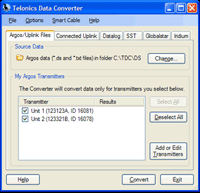 |
Telonics Data Converter (TDC) is used to convert raw data from Telonics transmitters into data reports and to display locations on Google Earth and Google Maps. You can review TDC reports in Microsoft Excel or other spreadsheet programs.
|
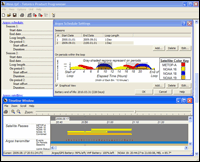 |
Telonics Product Programmer (TPP) is a powerful software tool used to program Telonics transmitters, and Telonics CR-5 and CR-7 collar release mechanisms. TPP gives you the ability to modify aspects of your Telonics GEN4 GPS and VHF transmitters including data collection and transmission intervals. TPP is designed for ease of use, with simple point-and-click navigation through the program.
|
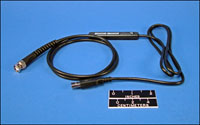 |
The TSC-4A and TSC-7 are multi-use USB interface cable and features a USB A type computer connector and a male BNC (bayonet style) embedded device connector. The BNC connector allows quick and easy attachment of various embedded device adapters (available separately).
|
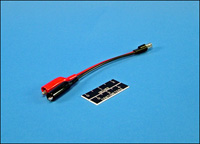 |
Adapter, female BNC to alligator clips for use with the TSC-9A cable. This adapter is used for systems where programming/download connections are made using the antenna tip or saltwater switch buttons.
|
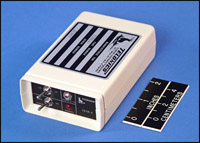 |
The TSTR-4 provides transmit indication for Argos PTTs (401.650 MHz). Provides both a visual indicator and audio tone with each transmission. Operates on a standard 9 volt battery. Designed specifically for short range (2-3 feet) testing of Argos transmitters.
|
Photo Gallery
Lithium Battery Shipping Regulations
Telonics Inc. ships all systems containing lithium batteries in accordance with the US Department of Transportation rules for hazardous materials set forth in 49CFR and the IATA Dangerous Goods Regulations.
Shipping dangerous goods can be complicated and confusing, consult a dangerous goods specialist if needed. The general requirements for shipping lithium batteries according to 49CFR are located in Part 173, Subpart 173.185 in the link below.
http://www.ecfr.gov/cgi-bin/text-idx?SID=e8334217c2c8d081457a5156872ad037&tpl=/ecfrbrowse/Title49/49cfrv2_02.tpl#0
Service Commitment
Since 1970, Telonics has built a reputation based on product quality, product support, service, and customer satisfaction. Telonics strives to produce the highest quality products, and to support those products accordingly.
Because of extreme conditions and the unpredictable nature associated with most telemetry applications, problems occasionally arise. Most problems can be resolved quickly. In all cases, we hope to be able to work in partnership with users to resolve problems to the user's satisfaction and to uphold our demonstrated commitment to excellence. If problems should arise, all products must be returned to our factory for failure analysis.
Warranty: GEN 4 GPS Systems - Show
Telonics warrants its GPS products to be free from defects in material and workmanship for a period of one year from the date acquired. Telonics does not warrant batteries.
Telonics designs and manufactures systems for a variety of applications using several satellite systems (GPS, Argos, Iridium, and Globalstar). At the time of manufacturing, Telonics equipment is tested to verify compatibility with the applicable satellite system(s). Telonics does not warranty equipment against changes in satellite system specifications or satellite operation after the date your equipment was manufactured. Unforeseeable or unplanned system changes would include, but are not limited to, elevated ambient noise levels in the radio frequency bands used for satellite communications, elimination of service in a region of the world, data outages due to technical problems within the satellite system network, or reductions in data transfer capability due to alterations in the constellation as a result of premature space vehicle failures or failure to replace space vehicles in a timely manner.
If a defect occurs, return the equipment to us within the proper time frame at the following address: TELONICS, 932 E. IMPALA AVENUE, MESA AZ USA 85204-6699. The customer shall arrange for and pay all shipping, insurance and related charges incurred in the shipment to and from Telonics under this warranty. Damage to any equipment resulting from misuse, accidents, unauthorized service, extreme conditions, or other causes, is excluded from this warranty. Telonics does not assume responsibility for loss or damage to equipment during shipment. Telonics does not assume responsibility for delays resulting from shipment on commercial or private carriers. We insure all equipment shipped from our facility and suggest that shipments to Telonics also be insured.
Upon the timely return to our facility, if defective, the product will be replaced or repaired at our discretion at no cost to the customer. This remedy is the exclusive remedy. This product is supplied without any further warranties or conditions, expressed or implied, including warranties of merchantability, quality or fitness for particular reason or those arising by laws, statutes or trade usage or course of dealing.
The entire risk, as to the results and performance of the product, is assumed by the customer. Neither Telonics, nor its suppliers, shall have any liability to the customer or any other person or entity for any indirect, incidental, special, or consequential damage whatsoever, regardless whether Telonics has been told of the possibility of such damages or that such damages might be foreseeable. Telonics has no responsibility or liability for the claims of any third party. The maximum aggregate to the customer, of Telonics and its suppliers, shall not exceed the amount paid by the customer for the product.
Warranty: VHF - Show
The VHF Transmitting Subsystem includes the following main components: internal digital and radio frequency electronics comprising the transmitter, power supply (battery), exterior packaging, transmitting antenna and attachment. A refurbished Subsystem is warranted as if the Subsystem was purchased new, unless otherwise stated.
Telonics warranties only the following with respect to the Subsystem:
1.1 The internal electronics (excluding batteries) are warranted to be free from defects in materials and workmanship and to perform to the operational specifications over the specified operating temperature range as published by Telonics for the rated operational life of the Subsystem (as recorded on the final test data sheet accompanying the unit), up to a maximum of three (3) years from the date of initial shipment of the Subsystem by Telonics.
1.2 The exterior packaging integrity of hermetically sealed subsystems are warranted for the full operational life of the Subsystem, up to a maximum of three (3) years from the date of initial shipment of the Subsystem by Telonics.
1.3 The exterior packaging integrity of polymerically sealed subsystems are warranted for the operational life of the Subsystem, up to a maximum of one (1) year from the date of initial shipment of the Subsystem by Telonics.
Limitations:
Although each Subsystem is supplied with a power supply in the form of a battery, Telonics does not manufacture batteries (electrochemical cells), and therefore cannot warranty the battery lifespan, mechanical integrity or other battery performance issues. However, Telonics conducts extensive testing of all types of electro-chemical subsystems to determine suitability to the application. Once an electrochemical system is chosen for a configuration, testing procedures are employed at Telonics to evaluate every individual battery that is installed in each transmitting subsystem. Even using these advanced testing procedures it is not possible to determine a specific battery's lifespan or mechanical integrity.
Telonics conducts tests to assure that each unit is transmitting at the power level selected by the user. Actual range performance is a system characteristic dependent upon numerous conditions including receiver sensitivity and noise figure, receiving antenna tuning and pattern, transmitter antenna integrity, line of sight conditions in the field, and vegetation and habitat conditions and other factors specific to individual study sites. Therefore it is not possible to warranty a minimum range that will be achieved for units deployed in the field.
"Packaging integrity" as applicable to 1.2 and 1.3 above, is limited to normal wear as encountered on the animal.
It is the purchaser's obligation to make certain that it orders the correct size and type of Subsystem for the particular type and size of animal that the Subsystem will be applied to, and no warranty is expressed or implied for any failure to meet operational specifications due in whole or in part to use of an incorrect size or type of Subsystem.
No warranty is expressed or implied with regard to abnormal events or damage due to human actions such as gunshot damage, vehicle encounters, etc. Further, no warranty is expressed or implied with regard to damage resulting from misuse, accidents, unauthorized service, extreme conditions, or other causes not specifically enumerated herein.
The entire risk, as to the results and performance of the Subsystem, is assumed by the customer. Neither Telonics, nor its suppliers, shall have any liability to the customer or any other person or entity for any indirect, incidental, special, or consequential damage whatsoever, regardless whether Telonics has been told of the possibility of such damages or that such damages might be foreseeable. Telonics has no responsibility or liability for the claims of any third party. Telonics' and its suppliers' maximum aggregate liability shall not exceed the amount paid by the customer for the Subsystem.
Exercising the Warranty
If a defect occurs, return the Subsystem to Telonics within the applicable time frame noted above at the following address: TELONICS, 932 E. IMPALA AVENUE, MESA AZ USA 85204-6699. Telonics does not assume responsibility for loss or damage to equipment during shipment. Telonics does not assume responsibility for delays resulting from shipment on commercial or private carriers. We insure all equipment shipped from our facility and suggest that shipments to Telonics also be insured. Customer shall arrange for and pay all shipping, insurance and related charges incurred in the shipment of Subsystems to and from Telonics under this warranty.
Upon the timely return to our facility within the applicable time frame noted above, if the exterior packaging integrity and/or internal electronics (excluding batteries) are defective, the Subsystem will be replaced or repaired, at Telonics' sole discretion, at no cost to the customer, other than shipping charges. This remedy is the exclusive remedy. This product is supplied without any further warranties or conditions, expressed or implied, including warranties of merchantability, quality or fitness for particular reason or those arising by laws, statutes or trade usage or course of dealing.
The above warranty extends only to the original purchaser and does not cover any Subsystem which is resold or otherwise transferred from the original purchaser to another party. The warranty will be extended to customers who purchase the Subsystem directly from a Telonics-authorized distributor.










